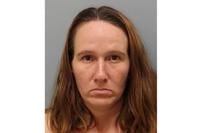Hope Reed was seeing stark disparities a decade ago at her high school in the suburbs of Columbia, South Carolina.
Nearly half the school's students were white, but the freshman remedial math classes were made up of almost all students of color. Reed, then chair of the math department at Blythewood High School, intervened with an experiment.
She taught a ninth-grade remedial class and used the regular Algebra 1 curriculum with nearly 50 students. They were honors students, and they were going to do honors work, she recalled telling them.
At the end of the year, about 90% of the students passed. The experiment convinced Reed that detracking — or getting rid of — could be a key to narrowing gaps in math performance. The school then tried going a step further, enrolling all ninth-graders in the same level of math class.
___
The , a coalition of eight newsrooms, is documenting the facing schools and . Members of the Collaborative are , The Associated Press, The Christian Science Monitor, The Dallas Morning News, The Hechinger Report, Idaho Education News, The Post and Courier in South Carolina, and The Seattle Times.
___
Racial achievement gaps have worsened in the wake of the COVID-19 pandemic and its disruptions to learning. Math far more than white 13-year-olds between the 2019-2020 and 2022-2023 school years, according to data from the ��ɫֱ�� Assessment of Educational Progress, also known as the Nation's Report Card.
Addressing those disparities is critical for strengthening , and for increasing their access to higher-paying jobs in STEM fields. Schools that have implemented detracking have aimed to level the playing field by exposing all students to the same higher concepts and standards.
Step into any American school and you’ll most likely find tracked classes, especially for math.
The practice took root during the 20th century. Following immigration waves, desegregation orders and the inclusion of special education students in classes, tracking separated those students deemed fit for higher learning from those seem as less intelligent, said Kevin Welner, an educational policy professor at the University of Colorado Boulder.
Tracking continues to reflect larger societal inequalities given that students from marginalized backgrounds often come to kindergarten or first grade already with measured achievement gaps.
Studies of schools that have detracked classes show have been narrowed with varying levels of success, Welner said. He pointed to the Rockville Centre school district on New York's Long Island as the gold standard. In the 1990s, it got rid of many tracked classes in its middle school and high school, and provided training for teachers to handle students of varying levels in the same classroom. As a result, the district has seen .
When Reed expanded detracking across ninth-grade math classes in the 2014-15 school year at Blythewood High, an additional class was also added for students who would have been placed in lower-level math classes. Those students received algebra lessons in the morning, and then took Algebra 1 with their full class.
The additional learning time offered a boost in confidence for students, Reed said.
“They didn’t go in there just blindsided, lost,” she said.
The extra math seminar also ensured the pace of learning did not slow down for students who would have been in a higher-level class.
Among the ninth-graders enrolled in the math seminar in 2014-205 was Kianna Livingston. Initially, she believed she wasn’t good at math. But Livingston, who is Black, said her confidence grew with her skills.
Livingston recalled feeling so assured of her math knowledge that she would help other students.
“It really allowed me to really own my leadership skills,” she said.
At the end of the school year — and to her surprise — she was recommended for honors Geometry the following year.
Still, tracking returned to Blythewood’s math classes.
A small group of students continued to struggle with the material despite the support from the math seminar, Reed said. By the middle of the 2014-15 school year, she realized they might fail and not receive math credit. So those students were moved to a slower-paced algebra class.
That tension highlights what some education experts say is one troubling aspect of detracking: The approach lacks flexibility for when students need more support.
“If you have kids who are really struggling at mathematics, they really need to be identified and probably treated differently in terms of curriculum and instruction than kids who are just sailing through math courses,” said Tom Loveless, an education researcher and former senior fellow at the Brookings Institution who has studied detracking for three decades
Loveless cited San Francisco as an example where detracking hasn’t helped. Since the school district eliminated tracks in middle and high schools starting in 2014, gaps between Black and Latino students and their white peers in San Francisco , he said.
Reed, who now works with just freshmen at Blythewood, said she still believes in detracking. The school’s end-of-course passing rate has never been as high as it was in 2014-15, when for at least half a year the school had completely detracked Algebra 1.
The average score for Black students on the exam was 80, up two points from the year prior. The average for white students was 83, an increase by less than one point from the year prior.
But after that first year, the school approached the setup differently. Rather than moving struggling students to another math class midyear, teachers started the school year with two lower-track math classes. The last remnant of her program, the math seminar, ended with the last school year due to changes in the school schedule.
Reed is keen on seeing this year’s end-of-course data to see how it compares with previous years, but she isn’t critical of the changes. At the core of her efforts, she said, is a desire to give all students the opportunity to try higher-level math classes.
“They just need to know they matter,” she said.
___
The Associated Press education team receives support from the Carnegie Corporation of New York. The AP is solely responsible for all content.








































